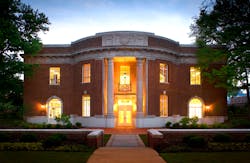LEED with Building Reuse: Improving Sustainability, Maintaining History and Strengthening Your Bottom Line
As we wrap up the height of summer, the United States is entering a time of year that is traditionally observed as hurricane season. Hazardous weather events, whether they are wind and rain or snow and ice, are never fun for building managers, in-house directors of real estate and development, facility managers and owners. It prompts most to review their insurance policies and building integrity.
It may also be a suitable time to reflect on how you can invest in your buildings, extend their usable lifespan, and make them work for you by renovating and pursuing a Leadership in Energy and Environmental Design (LEED) certification.
LEED is a globally recognized symbol of sustainability and one of the most widely used green building rating system in the world. It is available for all building types and provides a framework for healthy, highly efficient and cost-saving green buildings.
Why Pair LEED and Building Reuse?
As an architect, I hear from many clients that have older buildings, some of which hold a special place on their campus as “legacy buildings,” that they are considering demolishing and replacing. This is a particularly big step for those who are in urban areas or within an area of historic importance.
In these instances, one of the first things we evaluate is the prospect of reuse. In many instances, the latter may be a more viable cost-effective plan that leads to success across a multitude of priorities, both economically and socially.
Our approaches, and the “green” aspects, change with the institution as well as the nature of the historic fabric of an older building. While many times architects are addressing deferred maintenance on mechanical, electrical, and plumbing systems, we also look for opportunities to go beyond to pursue sustainable goals that strengthen our client’s bottom line for years after a project.
Two examples from within the higher education sector stand out as notable examples that can be applied to all facilities.
Redevelopment at Penn State University
When Penn State University undertook LEED redevelopment of their Burrowes and Ritenour buildings, the university and architects faced a number of obstacles. Both are brick and masonry buildings, and great care was taken to use both compatible materials, to weather similarly with the existing fabric, and be historically sensitive within the renovation.
As with these projects, a variety of upgrades would be considered to decrease overall energy consumption, both heating and cooling. These helps increase energy efficiency of the property reducing energy cost and/or demand on the center plant.
By replacing the original windows, which historically are single pane windows within non-thermally broken frames, we significantly decrease the amount of air infiltration and energy loss at these openings. The replacement of this windows, or addition of storm windows, reduces the heating and cooling needs of buildings, and improves user’s comfort.
If applicable, adding increased insulation at the exterior wall and roof, would further reduce the energy required to keep a comfortable environment. Referring to Penn State’s Burrowes Building, adding insulation not only met current energy codes, but they also perform 15% better in overall energy savings.
For its part, the Ritenour Building presented unique challenges for an LEED project. Due to the makeup of the existing exterior wall, it could not be insulated, as its dew point would be detrimentally shifted leading to a long term, slow deterioration.
To achieve the heating and cooling needs of the project, attention was directed to upgrades that would provide a bright and comfortable interior with new modern mechanical systems and high efficiency windows. Individual fan coil units were utilized to provide cooling and warm in the immediate proximity to users while reducing heating and cooling needs for the rest of the building.
Increasing Building Resiliency and Accessibility
As climate change continues, the anticipation of greater storms and outages need to be anticipated. Lowering the overall energy consumption is important to the bottom-line of organizations, while also being an important consideration to its island ability, which is a building’s ability to support emergency systems during a wider community power-outage. It is also why the focus on passive accessibility (i.e., non-elevators or lifts) is something we strive for, though there are certain legacy buildings and historic elements where this is not achievable.
The thought of an elevator within a historic building may bring a pressing question to mind. How do architects maintain the historic integrity of a building that is treasured by its tenants, owners and managers while adhering to ADA requirements?
At the Ritenour project, the need for a new elevator and elevator shaft was identified and built adjacent to the exterior wall. Architects were again charged with maintaining the building’s history and did so by incorporating the existing punched windows into the renovation, adding a glass panel in the elevator so these exterior existing windows not only remained but were kept as vision glass in lieu of blanking off due to the elevator shaft directly behind them. Thus, they incorporated these historic elements into the new construction.
Redevelopment means that projects must take all ADA requirements into account. A priority in today’s market is to go beyond ADA and provide an inclusive experience to visitors, parents and students. Increased inclusiveness is the key as we look to create spaces that can be utilized comfortably by all tenants. While this does begin with evaluating the existing entrances and exits to see how they can be modified or re-positioned to allow for ease of access, it continues to the public spaces and restrooms so all can feel welcomed in the space.
At the existing Ritenour Building, east wing renovation, we purposively created a new entrance to increase connectivity to the campus and provide a new accessible entrance to the building. This new entrance was designed to seamlessly work with the historic fabric of the building and offers a new elevator that provides an accessible entrance to the building. Similarly, the west renovations regraded the site to reposition the new entrance, thus eliminating stairs.
Within the Burrowes project, a different approach was taken with two new stair/elevator cores being inserted into the existing building. This provides ready access across the building for individuals with mobility challenges, as well as access to single user restrooms.
In each case, the historic original entrances have large ornate stairs that are challenging, with any modification having a detrimental effect on the historic visage of the building. Both renovations shifted the “main” entrance to either a new entry or repositioning what was seen as secondary to center stage for increased accessibility and commonality of experience.
There are steps that can be taken to achieve both critical aspects of modern design, some legally, which lead to cost savings, a stronger bottom line in the future, and continued use of these valuable university assets.
About the Author:
Kyle Kernozek, AIA LEED AP, is an associate principal at BLT Architects (BLTa) – A Perkins Eastman Studio.
About the Author

Contributed Author
BUILDINGS partners with industry experts to bring you contributed content covering the hot topics for building owners and facility professionals.
